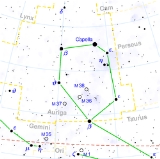
Iota Aurigae
Encyclopedia
Iota Aurigae is a star
in the constellation
Auriga
. It has the traditional name Al Kab, short for Kabdhilinan, from the Arabic الكعب ذي العنان al-kacb ðīl-cinān "the ankle of the rein holder (charioteer)". Under the name Alkab, this star is a marker on the astrolabe described by Geoffrey Chaucer
in his Treatise on the Astrolabe
in 1391. In Antonín Bečvář
's atlas it has the traditional name Hassaleh.
Iota Aurigae is an orange K-type
bright giant
with an apparent magnitude
of +2.69. It is approximately 512 light-years from Earth, and is dimmed by approximately 0.6 points of magnitude by interstellar dust.
It is known as 五車一 ( the First Star of the Five Chariots) in Chinese.
, Greece, Reffert et al. announced the detection of two substellar objects orbiting Iota Aurigae in 2:1 resonance. Such companions would be brown dwarf
s with orbital periods of approximately 2 and 4 years. No minimum mass for the candidates was provided. So far the detection has not been confirmed, though Hekker et al. (2008) listed significant radial velocity variations at periods of 767 and 1586 days.
Star
A star is a massive, luminous sphere of plasma held together by gravity. At the end of its lifetime, a star can also contain a proportion of degenerate matter. The nearest star to Earth is the Sun, which is the source of most of the energy on Earth...
in the constellation
Constellation
In modern astronomy, a constellation is an internationally defined area of the celestial sphere. These areas are grouped around asterisms, patterns formed by prominent stars within apparent proximity to one another on Earth's night sky....
Auriga
Auriga (constellation)
Auriga is a constellation in the northern sky. Its name is Latin for 'charioteer' and its stars form a shape that has been associated with the pointed helmet of a charioteer. It was one of the 48 constellations listed by the 2nd century astronomer Ptolemy, and remains among the 88 modern...
. It has the traditional name Al Kab, short for Kabdhilinan, from the Arabic الكعب ذي العنان al-kacb ðīl-cinān "the ankle of the rein holder (charioteer)". Under the name Alkab, this star is a marker on the astrolabe described by Geoffrey Chaucer
Geoffrey Chaucer
Geoffrey Chaucer , known as the Father of English literature, is widely considered the greatest English poet of the Middle Ages and was the first poet to have been buried in Poet's Corner of Westminster Abbey...
in his Treatise on the Astrolabe
Treatise on the Astrolabe
A Treatise on the Astrolabe is a medieval essay on the astrolabe by Geoffrey Chaucer. It begins:or, in a more modern English spelling,According to the introduction, the work was to have five parts:#A description of the astrolabe...
in 1391. In Antonín Bečvář
Antonín Bečvář
Antonín Bečvář was a Czech astronomer who was active in Slovakia. He was born in Stará Boleslav. Among his chief achievements is the foundation of the Skalnaté Pleso Observatory and the discovery of the comet C/1947 F2 .Bečvář is particularly important for his star charts: he led the compilation...
's atlas it has the traditional name Hassaleh.
Iota Aurigae is an orange K-type
Stellar classification
In astronomy, stellar classification is a classification of stars based on their spectral characteristics. The spectral class of a star is a designated class of a star describing the ionization of its chromosphere, what atomic excitations are most prominent in the light, giving an objective measure...
bright giant
Bright giant
The luminosity class II in the Yerkes spectral classification is given to bright giants. These are stars which straddle the boundary between giants and supergiants, and the classification is in general given to giant stars with exceptionally high luminosity, but which are not sufficiently bright...
with an apparent magnitude
Apparent magnitude
The apparent magnitude of a celestial body is a measure of its brightness as seen by an observer on Earth, adjusted to the value it would have in the absence of the atmosphere...
of +2.69. It is approximately 512 light-years from Earth, and is dimmed by approximately 0.6 points of magnitude by interstellar dust.
It is known as 五車一 ( the First Star of the Five Chariots) in Chinese.
Unconfirmed substellar companions
During the Extreme Solar Systems conference held on June 25–29, 2007, in SantoriniSantorini
Santorini , officially Thira , is an island located in the southern Aegean Sea, about southeast from Greece's mainland. It is the largest island of a small, circular archipelago which bears the same name and is the remnant of a volcanic caldera...
, Greece, Reffert et al. announced the detection of two substellar objects orbiting Iota Aurigae in 2:1 resonance. Such companions would be brown dwarf
Brown dwarf
Brown dwarfs are sub-stellar objects which are too low in mass to sustain hydrogen-1 fusion reactions in their cores, which is characteristic of stars on the main sequence. Brown dwarfs have fully convective surfaces and interiors, with no chemical differentiation by depth...
s with orbital periods of approximately 2 and 4 years. No minimum mass for the candidates was provided. So far the detection has not been confirmed, though Hekker et al. (2008) listed significant radial velocity variations at periods of 767 and 1586 days.

